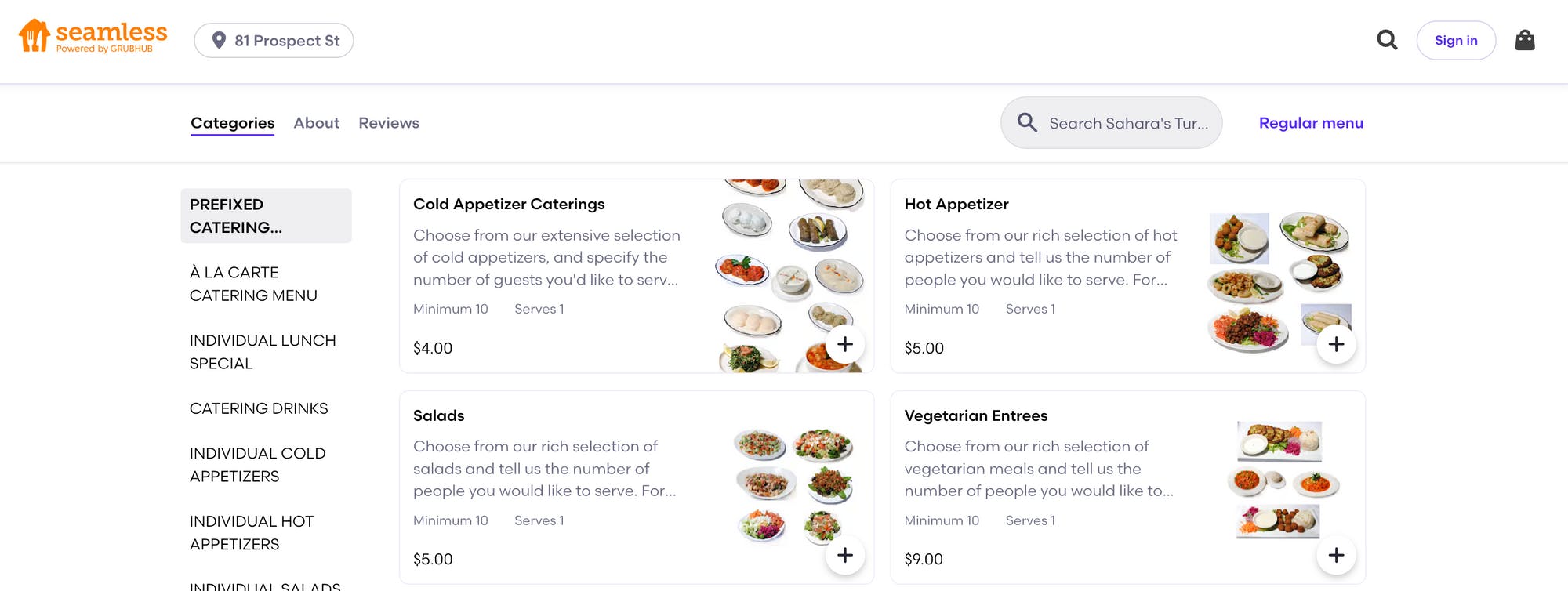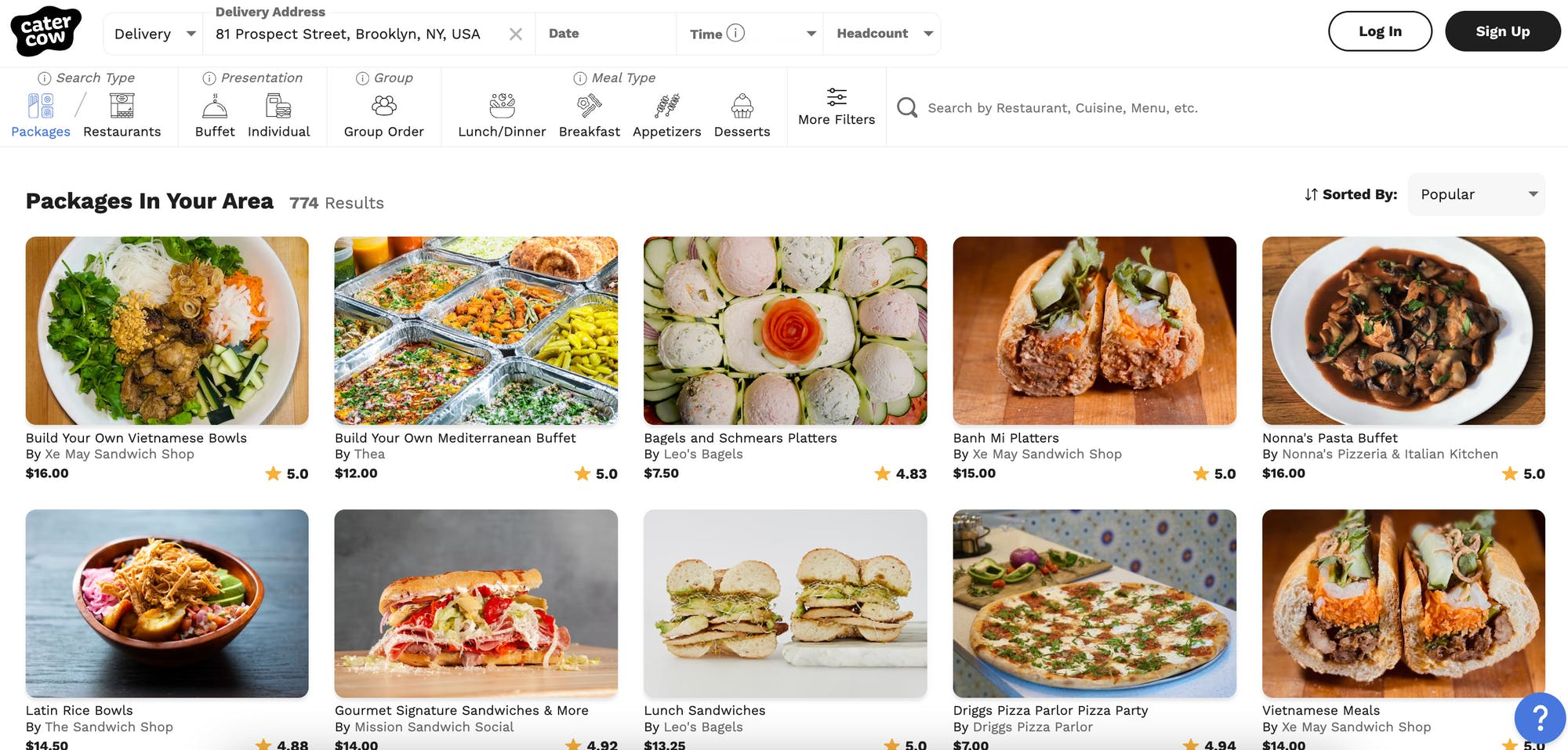Top 9 Catering Services and Online Platforms, Compared

Written by Sean Li • July 22, 2025

With so many catering platforms that help you order from a wide variety of restaurants and caterers, it may be difficult to get a sense of what each offers and the pros and cons. Here’s a breakdown of 10 of the most popular platforms.
1. Grubhub Catering & Seamless Catering
Grubhub and Seamless were some of the first marketplaces for food delivery. Back in the early 2000s, Seamless got its start by providing a platform for investment bankers and lawyers working overtime to order food subsidized by their companies. In 2013, Seamless merged with GrubHub and then in 2021 Just Eat Takeaway bought both before selling to Wonder Group in 2024. While they have a section of the website dedicated to corporate orders and catering, they both were overtaken by DoorSash in 2018. Today, both businesses are just hanging on and hoping a NY makeover for Seamless may recussitate the brand.
Consistent with their historical focus on enabling select employees to order over-time meals, most office who use GrubHub are ordering individually, not family-style buffets or platters.
Pros:
- Large variety of restaurants across the nation.
- Transparent interface to see full menus and prices.
- Easily switch between ordering for work and ordering outside of work.
- Order on-demand and same-day easily.
Cons:
- Since almost any restaurant can join, curation and vetting is limited. This makes it hard to narrow down which are the best for your office.
- There are limits to how many people can join a cart and some restaurants do not allow more than 20 people's orders.
- Focus is on traditional food delivery which means a lot of options more tailored for dinner at home than office lunch (e.g. punctuality, professionalism, budget).
- Catering is a small part of their business so menus and photos may be outdated.

2. DoorDash Catering and Group Orders
DoorDash is the most popular platform for food delivery in the USA. Unlike Grubhub where many of the deliveries are done by the restaurants themselves, DoorDash has a fleet of contract drivers to pick up and deliver to you. This fleet enables customers to order food from restaurants which are further away. DoorDash has also started offering more tools for offices like DoorDash gift cards.
Pros:
- Huge selection of different restaurants nationwide.
- Transparent menus and prices with many photos of individual dishes.
- If you have employees scattered throughout the country, you can provide them with DoorDash gift cards.
- Order on-demand and morning-of easily. You can wait until the last minute to place your order.
Cons:
- As with many delivery apps, there may be issues with reliability and timeliness due to drivers and restaurant delays. Problems are exacerbated since restaurants are further away than with Seamless or Grubhub.
- Many drivers deliver carelessly. CaterCow gets reports frequently from disgruntled DoorDash customers who seek delivery with care.
- Various fees add up and can become cost prohibitive if you have a tight budget.
- Interface is focused on typical food delivery and not necessarily office group catering. Catering menus may be limited.
3. CaterCow
CaterCow is a service dedicated specifically to food for groups and office catering. Menu options are carefully curated from restaurants who have been vetted to deliver punctually and cook high-quality, well-travelling food. Food photos are authentic and in actual delivery containers. CaterCow gives you the option of ordering on behalf of your team or group ordering (i.e. letting each individual choose what they want). Finally, CaterCow has a "white glove" service if you need an account manager for setting up daily lunches and taking care of dietary needs.
Pros:
- Service is focused specifically on ordering for groups. Attention to menu curation and vetted restaurants to minimize reliability issues that may cause stress at the office.
- Thoughtfully curated and compiled packages ensures there isn't too much or too little food--especially proteins.
- Because catering orders are larger than typical food delivery, CaterCow's delivery service areas are quite large.
- Ability to group order with employee budget limits and allowances — meals are delivered labeled with dietary details and name of employee.
- Support team is incredibly attentive, easy to reach via phone or email, and the only catering company with 5-Star Google reviews.
Cons:
- Many restaurants require a minimum of 8 people and some may require 15+.
- You cannot find every restaurant and menu on the website. Restaurants are limited because of their vetting and curation process.
- Not yet available nationwide. CaterCow offers service with a 20 mile delivery radius around Austin, Boston, Chicago, Denver, Los Angeles, New York City, San Francisco, San Jose, Seattle, and Washington DC

4. ZeroCater
ZeroCater is the OG when it comes to office catering services. As one of the first concierge services to help office managers with organizing food, ZeroCater has an army of account managers and food attendants to organize office meals, setup large buffet spreads with chafing dishes and labels, and coordinate office snacks and micro-kitchens. ZeroCater sets up contacts with its customers as well as its restaurant partners, and is best for large companies who have a predictable and consistent food ordering need.
Pros:
- Known for its concierge services and full suite of enterprise catering solutions, including providing attendants, chafing dishes, labels, as well as organizing office snacks and micro-kitchens.
- Some restaurants may have exclusive partnerships with ZeroCater.
- Account managers handhold the entire process for you given your budget, food preferences, and dietary needs.
Cons:
- You must order through an account manager instead of ordering directly through a website, which means there will be back and forth communication.
- Lack of transparency of what menus you can choose from. You must work with your concierge.
- Services are geared toward enterprise and large companies with consistent and predictable daily needs.

5. Cater2.me
Similar to ZeroCater, Cater2.me provides white glove concierge for office catering. Some customers switch between the 2 platforms because many services provided are nearly identical. More recently due to COVID, the two have begun to diverge in product offerings. Cater2.me now offers a concierge for organizing virtual experiences and online gatherings. They have also experimented with providing vacuum-sealed prepared meals meant to be stored in the refrigerator.
Pros:
- Similar to ZeroCater, good concierge services and white-glove needs such as providing attendants, chafing dishes, labeling, etc.
- Some restaurants are exclusive with Cater2.me.
- Account managers handhold all of the ordering and ask you to approve of a proposal given your budget and dietary preferences.
Cons:
- The above approval and changes to the menu proposal may require a good amount of back and forth. You are at the whim of (hopefully) getting a good account manager.
- Difficult to see what menus you can choose from before speaking with an account manager.
- Prioritization of larger companies with predictable and constant daily needs for catering.
6. Fooda
Fooda is known for their innovative offering in the office catering industry by providing pop-ups — they contract with different restaurants who bring food and a few staff to serve in a designated common area or lobby of the building. Effectively operating as a cafeteria replacement, companies can either cover their employees’ food selection or provide a subsidy. Fooda also has an online portal to order directly and also have a concierge similar to ZeroCater and Cater2.me if you’re looking for a drop-off delivery.
Pros:
- Unique pop-up offering. You can have multiple if you have a large number of folks in your common area or building lobby. Ability to fully or partially subsidize your employees’ lunches.
- Similar to ZeroCater and Cater2.me, good concierge services and white-glove needs.
- Online portal gives some transparency in restaurants.
Cons:
- Because a pop-up is more coordination and legwork for the restaurant (providing staff, equipment to serve hot food, etc.), there is a higher likelihood of logistical kinks compared to a normal food delivery.
- Without a full subsidy, it may be difficult to predict how many of your employees will utilize the pop-up, which may limit the number of menu options since the headcount needs to be high for it to be worth it to the restaurant.
- Requires some upfront legwork of coordination with a Fooda account manager.
7. EAT Club
EAT Club was the industry pioneer of individual ordering in the office — they were one of the first to allow each individual employee to choose what they want to eat from a large menu. EAT Club operates by both cooking their own food and purchasing it from various restaurants. They consolidate the food from various sources at a central distribution warehouse, and re-sort it before it is delivered to your office. Because of the large operational overhead, EAT Club has struggled to expand and was acquired by UK-based Compass Group.
Pros:
- Wide range of features for individual ordering including setting limits and employee allowances. Minimal work for the office manager since the individual is in charge of meals.
- Daily menu includes a large variety of EAT Club cooked and restaurant prepared foods since all the food is being assembled at a central distribution center.
- EAT Club also can provide a cubby at your office that allows for easy organization of food and helps with temperature control.
Cons:
- Little control over menus. Difficult, if not impossible, to request a specific cuisine on a specific day.
- Lack of customizations since food is mass produced and collected. Due to the way it operates with food from various sources collected into a centralized warehouse before being delivered, some have complained about food quality.
- Lack of menus like breakfast, and lack of flexibility with delivery operations outside of standard lunch hours.
8. ezCater
ezCater is the largest catering-foremost platform and operates a website that has a wide variety of restaurant options nationwide in big cities and small towns alike. Ordering catering is primarily self-service with limited concierge and account managers. In years past, ezCater had a large army of customer support representatives to help out, but that is seemingly going the way of AI with customers reporting great difficulty in reaching a human.
Unlike most other platforms, ezCater is unique in having partnerships with chains like Subway and Denny’s, which further helps expand their nationwide reach.
Pros:
- Many restaurant choices and operates throughout the entire nation.
- Transparent and accessible menus with pricing, so you can look at what is offered.
- Works with classic chains that everyone knows such as Subway, Denny’s, Olive Garden, and Taco Bell.
Cons:
- Ordering is primarily self-service. Limited account manager resources if you need it.
- Almost any restaurant can join. Curation / vetting is limited, so it’s hard to narrow down which are the best for your office.
- Lack of photos, so difficult to know what you’re getting.
- Challenging to understand portion sizes – you'll be guessing just how much guacamole you may recieve.
9. Forkable
Like EAT Club, Forkable specializes in individual employees choosing their meals and positions itself as a better version of EAT Club that offers better customization of meals and higher quality food. Unlike EAT Club, Forkable does not have a centralized warehouse where food from various sources is amassed. Instead, Forakble drivers pick-up from the restaurants and deliver directly to you. Forkable can also auto select employee meals based on individual preference.
Pros:
- Wide range of features for individuals ordering including setting limits and employee allowances. Minimal work for the office manager since the individual is in charge of meals.
- Minimal food waste since delivery is what employees selected.
- Ability to auto select meals based on individual preferences.
Cons:
- Number of options may become limited due to restaurant-to-office distance restraints. Less number of options than EAT Club since there is no distribution warehouse that amasses food.
- If drivers are picking up deliveries from multiple restaurants before coming to the office, food may become lukewarm during transit if there are delays at the restaurant and on the road.
- With tax, delivery, and service fees, the total bill on top of your employee limit / allowance might become steep.
With so many different online catering services and platforms, you and your team deserve to use one that is best fit for your needs! Every platform has its pros and cons depending on the services that your office wants. We hope this was a helpful summary and comparison of what's out there.

Disclaimer: Best efforts were made to research and compare services fairly based on public reviews and available information online. This article is hosted on catercow.com



